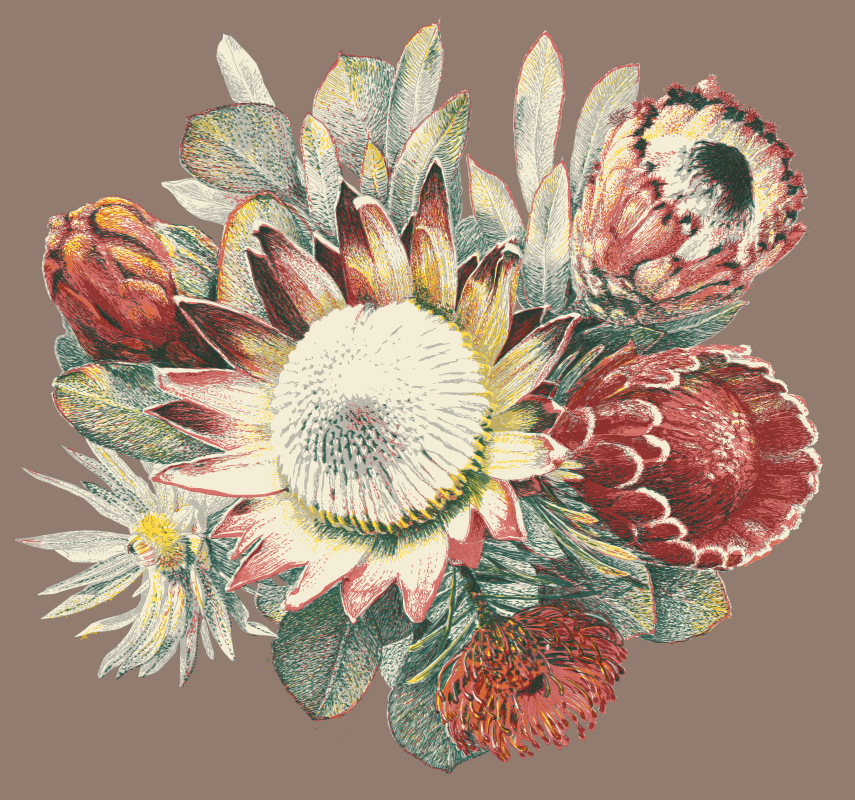Dear Reader, in this age of AI created content, please support with your goodwill someone who works harder to provide the human-made. Sign up at the top of the lefthand column or bottom of this page. You will receive my hand illustrated monthly newsletter RESTORE NATURE and access to the biodiversity garden design course as I write...and nothing else, I respect your time. I am also removing the advertizing as best I can as its become intrusive inappropriate and pays me nothing.
A protea drawing on floral fabric and prints
 Protea drawing for upholstery and other prints
Protea drawing for upholstery and other printsProteas are found elsewhere in Africa and they have relatives in Australia, but they have come to stand for the Western Cape of South Africa, for Fynbos, as they grow here in many forms and were once abundant.
Which proteas are found in the protea drawing ?
The proteas in the drawing are the large open formed king protea, Protea cynaroides, on which I have written before. The reddish proteas are the bearded P. magnifica, the closed egg shape of P. grandiceps, and the pure red Venus, a horticultural hybrid between P. aristata and P. repens bred by Pam Michell in the Banhoek valley outside Stellenbosch. The pincushion is Leucospermum cordifolium, and the rosette of silver leaves with a small yellow flower at the center is the flower of the silver tree, Leucondendron argenteum, which is highly endangered in the wild. All of these proteas are common horticultural plants in South Africa.
A little information on the proteas
Protea repens, one of the elements in the Venus cross, which you can see on the right of the protea drawing, is also known as the sugar bush. It bears a lot of nectar, fed on by sugarbirds, and this used to be collected and boiled down to make bossies-stroop or bush syrup as an element of historical Cape medicine. The other contributor, P. aristata has needle like leaves and dark pink blooms, and has come close to extinction. It disappeared for almost half a century.
P. magnifica, also known as the queen protea, has the second largest bloom. The king is the largest. The queen's coloring is incredibly varied, from whitish to pale green through pink to dark carmine. This queen has a woolly beard ! The bracts have woolly edges which may be white, golden brown or purply black. Similarly the woolly centre may be white, brown or black. The outer wool color on the bracts need not be the same as that in the center, giving rise to a lot of visual variation.
The protea with the closed form and broad leaves on the left, P. grandiceps, has marginal endangered status. It is also known as the princess protea. The bush is stocky and very slow growing and pollinated by sunbirds and sugarbirds, like many of the proteas.
Proteas and upholstery fabric
I created this protea drawing in several colors to be printed as a repeat on upholstery fabric in about 1998. This is the reason for the muted colors which are on the grey side of natural. I thought that South African flowers depicted in florals could replace the use of Eurasian floral fabrics like Sanderson and chintz.
This
has eventually happened to a degree. Proteas became trendy and then
almost mainstream on cushions and décor items. But when I started
there was no market for such things. South Africans then had little
taste for our own flora in the form of florals. Twenty two years have
gone by and a market has formed. I guess the tourism industry which
exploded in 1994 helped as the visitors wanted to see something more
uniquely and typically South African, and then South Africans
followed suit, after the rest, as usual. The trouble with tourism is you can delight different people with the same local attractions again and again and again. It does not really make a market that diverse. So beyond the big five of our flowers, the rest get no attention at all.
------
------
------
the greenidiom regenerative gardening blog
------
the all inclusive website blog
Your first paragraph ...
Restore Nature Newsletter
I've been writing for four years now and I would love to hear from you
Please let me know if you have any questions, comments or stories to share on gardening, permaculture, regenerative agriculture, food forests, natural gardening, do nothing gardening, observations about pests and diseases, foraging, dealing with and using weeds constructively, composting and going offgrid.
SEARCH
Order the Kindle E-book for the SPECIAL PRICE of only
Prices valid till 30.09.2023
Recent Articles
-
garden for life is a blog about saving the earth one garden at a time
Apr 18, 25 01:18 PM
The garden for life blog has short articles on gardening for biodiversity with native plants and regenerating soil for climate amelioration and nutritious food -
Cape Flats Sand Fynbos, Cape Town's most endangered native vegetation!
Apr 18, 25 10:36 AM
Cape Flats Sand Fynbos, a vegetation type found in the super diverse Cape Fynbos region is threatened by Cape Town's urban development and invasive alien plants -
Geography Research Task
Jan 31, 25 11:37 PM
To whom it may concern My name is Tanyaradzwa Madziwa and I am a matric student at Springfield Convent School. As part of our geography syllabus for this
"How to start a profitable worm business on a shoestring budget
Order a printed copy from "Amazon" at the SPECIAL PRICE of only
or a digital version from the "Kindle" store at the SPECIAL PRICE of only
Prices valid till 30.09.2023







